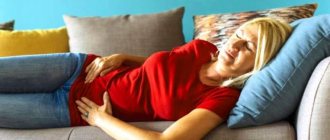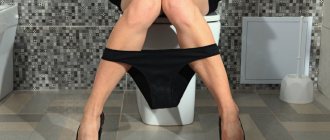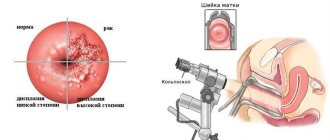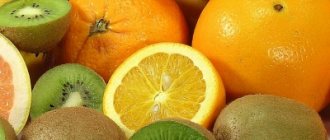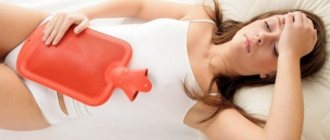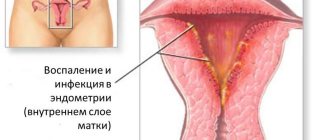Today we will talk about the reasons why the lower abdomen hurts in women; there are many reasons for this of varying degrees of severity.
Almost every woman has experienced unpleasant aching and pulling sensations in the lower abdomen at least once in her life.
Physical and strength exercises, hard sexual intercourse, lifting heavy objects - any of the above actions can cause a feeling of pain in the lower abdominal cavity.
If we do not take into account physiological causes (before and during the menstrual cycle), which do not require treatment, acute pain in a woman in the lower abdomen on the right or left may be associated with organic causes (inflammatory processes, damage to the pelvic organs and peritoneum) and be an alarming signal development of inflammatory and neurological pathologies.
Plus, diseases of the digestive system, kidney problems, infectious gynecological diseases - all this can be a consequence of a woman experiencing pain of various types (pulsating, sharp, pulling) in the lower abdomen.
Etiology of the phenomenon
Why does it hurt on the left side of the lower abdomen? Disorders in any of these organs can cause pain in this area. It can be paroxysmal, constant, aching, dagger-like, encircling, etc.
Pain in the lower abdomen on the left side is associated with:
- in women in 60-70% of cases with gynecological pathology;
- PMS – 65-85%;
- gastroenterology – 15-35%;
- spinal pathology - 7-15%.
In addition, the culprits may be: diabetes, connective tissue diseases, hernias and cysts, respiratory diseases.
Main symptoms
Doctors consider severe pain in the lower abdomen during menstruation as a disorder of menstrual function. According to statistics, in every third representative of the fairer sex such sensations are accompanied by additional symptoms:
- upset stomach, vomiting, nausea;
- loss of consciousness.
Pain syndrome, as a rule, appears on the first day of the cycle and subsides by the third day. It can have a twitching, cramping, aching character, sometimes the lower back hurts a lot. Often, against the backdrop of debilitating sensations, a woman’s mood and psycho-emotional background changes. She can be whiny, irritated, anxious and even aggressive. Sleep is disturbed. It is important to understand that such manifestations cannot be prolonged and should pass without the use of medications within a few days after the start of menstruation.
Depending on the main symptoms, doctors distinguish several degrees of painful periods:
- Mild degree. It is characterized by periodic moderate pain, which does not in any way affect the woman’s performance. Such sensations are easy to bear without taking painkillers. But even a mild form cannot be ignored, as it can very quickly develop into a pronounced syndrome that will significantly disrupt the usual way of life.
- The average degree is characterized by rather prolonged, nagging pain in the lower abdomen during menstruation, accompanied by nausea, weakness, and chills. Often a woman cannot work normally and lead a normal life. This situation requires medical correction and diagnosis of the causes.
- Severe degree is very severe pain in the lower abdomen on the right, in the middle, on the left, radiating to the lower back and accompanied by high fever, diarrhea, vomiting and even fainting. Severe degrees are usually associated with inflammation and pathologies of the genital organs. In this case, immediate hospitalization is required.
Sharing pain
Pain is divided according to the mechanism of occurrence and its characteristics, which is important for making a diagnosis:
- Visceral pain is the result of impaired peristalsis of hollow organs as a result of muscle spasms or stretching. Such pains are usually aching and dull, but with flatulence they can become cramping. They can radiate and become reflected.
- Somatic pain is constant and clearly distributed. Often has a bright character.
- Referred pain is the result of irradiations. It is reflected from organs located outside the left half of the abdomen, for example, lungs, pleura, etc.
Formation of pain
They are different for hollow and parenchymal organs. The parenchymal ones have a dense capsule with many nerve pain endings that respond to damage.
In hollow organs, pain occurs when the muscle layer is stretched; stretching the mucous membrane does not produce pain, because there are no pain receptors here.
Pathologies arising in the left half of the abdomen:
- dystrophy of the organ or its walls;
- inflammation;
- circulatory disorders;
- functional and organic disorders.
In what cases is self-treatment acceptable?
Menstrual pain can be treated at home. Medical intervention is not required if there are no severe pains or heavy discharge with blood clots.
Ways to reduce pain:
- limiting physical activity;
- rest in the fetal position;
- warm shower or bath with sea salt for 10-15 minutes;
- compresses;
- light abdominal massage;
- refusal of dairy, meat products, fruits;
- pain reliever (No-shpa, Spazmalgon, Ketonal, Ibuprofen);
- tincture of valerian for nervous tension and overexcitation.
Over the next 2 weeks, you can eat foods from the white list. You need to eat often, in small portions. At the end of the diet, you can switch to regular food, but it is better to give up fried and spicy foods for another 1-2 weeks.
Black list of products:
- dairy products;
- bread;
- fatty, fried;
- alcoholic, carbonated drinks;
- coffee;
- seasonings, spices, salt, sugar;
- honey;
- fresh vegetables, fruits, berries;
- first broths.
White list
- mashed potatoes;
- porridge with water;
- boiled eggs;
- crackers;
- green, black tea;
- herbal decoctions;
- soups with a second broth;
- baked apples, pears;
- boiled chicken breast;
- fish.
Gastrointestinal problems
Pain with them is always associated with eating, with the exception of tumors - there the pain is constant. In addition to this, there are complaints of dyspepsia, flatulence, nausea and vomiting, heartburn and belching.
Diseases of the small intestine cause severe cutting or cramping pain. The absorption of nutrients is always impaired, which causes dehydration with diarrhea, loss of vitamins and protein.
Enteritis is clinically similar to gastritis. Patients' complaints mainly boil down to pain in the lower abdomen on the left. All this is accompanied by fever, nausea, and there is a lot of mucus and undigested food particles in the stool.
Malabsorption syndrome - the mucous membrane loses the ability to absorb certain products, such as milk. In this case, there is diarrhea with drops of fat, a lot of gas with bursting and cramping pain, rumbling in the stomach and a taste in the mouth.
Prevention
Prevention of pain in the lower abdomen involves timely consultation with a doctor at the first signs of illness. To avoid increased gas formation, you need to adhere to a special diet. It is usually recommended to exclude dairy products, raw vegetables and fruits, legumes, fatty, fried, salty or sweet foods from the diet. Observing personal hygiene rules will help you avoid diseases of the genitourinary system. Women need to visit a gynecologist for preventive purposes at least once every 6 months. Pregnant women should register with a doctor in a timely manner and undergo all necessary examinations.
Pathologies associated with pain
Pathologies in which the left side of the abdomen hurts:
- Intestinal irritation - the exact cause of the pathology is not fully understood. It occurs more often in middle-aged women. The course is chronic. Regularly there is a cramping pain in the lower left side of the abdomen after eating; after defecation, the pain disappears, but false urges appear again. There is also bloating and stool instability (alternating constipation and diarrhea). It is provoked by fried foods, anxiety, menstruation. There are no morphological changes in the intestinal cells.
- Nonspecific ulcerative colitis is a hereditary pathology, an autoimmune process. The pain begins in the rectum and spreads upward, the intestinal wall becomes covered with ulcers.
- Diverticulosis - protrusions appear in the intestinal wall, interfering with peristalsis. Typical for the elderly. They can become clogged with feces and then a throbbing pain occurs in the left side of the abdomen. At the same time, there is constipation and black stool due to bleeding. Treatment is only surgical.
- Colon polyps create mechanical obstacles to water absorption, cause constipation, even obstruction. Pulling pain in the left lower abdomen.
- Atonic constipation is more common in the elderly. The main symptom is chronic constipation, bloating, dull arching pain.
- Colitis - aching pain in the lower abdomen, tenesmus, gas, mucous diarrhea mixed with blood.
- Intestinal obstruction - cramping pain in the abdomen, not associated with food, can occur at any time of the day. The abdomen is distended, asymmetrical, nausea and frequent vomiting are noted. As the pathology progresses, the pain subsides after 2-3 days, but this is a dangerous symptom indicating intestinal necrosis.
- Colorectal cancer lasts for a long time without symptoms. The pain is usually vague and weak; do not depend on food. There is often blood in the stool, the stomach is swollen and rumbling. Then the pain increases.
- Why does it hurt on the left side of the lower abdomen? This also happens with sigmoiditis - inflammation of the mucous membrane of the sigmoid colon. It becomes the result of other intestinal inflammations: UC, Crohn's disease, dysbacteriosis, atherosclerosis of the sigmoid vessels, complications of radiation therapy, etc. The clinical picture of all sigmoiditis is common: it hurts in the lower left with nagging pain without irradiation. When drinking milk, alcohol, large amounts of coarse fiber, the pain intensifies, as well as when driving for a long time or walking on uneven terrain. Why does it hurt in the lower left with sigmoiditis during bowel movements? The pain occurs from stretching the intestinal walls with feces, and after defecation the walls stick together and cause pain again. Tenesmus is also a specific symptom.
Endometriosis
Endometriosis is a benign growth of the lining of the uterus. It can develop both in the genital and other abdominal organs of a woman. Endometrial cells that extend beyond the mucous membrane multiply, following a cycle. Menstruation is disrupted: there is more bleeding and it takes longer to discharge.
Typically, the cycle for endometriosis lasts more than 1 month. The pain can be either diffuse or localized, dull or sharp, occur before menstruation or occur along with it. Spotting and spotting appears 2-3 days before menstruation and 2-3 days after it. The affected organ (not always just the uterus) increases in size, begins to bleed during menstruation, and infertility is also possible. Common symptoms include fever, weakness, nausea, and vomiting.
Discomfort in the left hypochondrium
Here the pain can be acute - observed when the walls of the stomach, intestines, spleen, and kidneys are perforated.
Dull pain - with sluggish gastritis, aching - with duodenal ulcer.
If there is pain in the left lower ribs, it could be:
- inflammation of the pancreas;
- stomach ulcer or cancer;
- spleen diseases;
- hiatus hernia;
- vascular pathologies;
- pleurisy and pneumonia;
- osteochondrosis;
- injury.
With pancreatitis, aching pain in the left hypochondrium appears with limited damage to the tail of the pancreas. The spread of inflammation causes girdling pain, cutting in nature, radiating under the left shoulder blade and collarbone. The pain intensifies after eating overcooked, fatty and sweet foods, as well as alcohol. In a chronic process, pain is typical in the second half of the day. Hunger relieves pain, so the patient often tries not to eat and loses weight.
In pathologies of the spleen, pain appears when the spleen is enlarged due to Filatov’s disease, liver cirrhosis, SLE, leukemia. It is associated with capsule stretching. The more it is stretched, the greater the pain.
In a chronic process, with a gradual enlargement of the spleen, the pain is nagging or aching. In addition, there are:
- asthenia;
- migraine;
- vertigo (dizziness);
- heat;
- myalgia;
- hyperhidrosis;
- tendency to catch colds.
When the spleen ruptures, the pain associated with the injury is sharp, dagger-like. Characteristically, hemorrhage occurs around the umbilical ring and pain radiates to the back. Calling an ambulance is required.
With cardiomyopathy, tachycardia, fatigue, burning behind the sternum, and shortness of breath are observed. A heart attack is characterized by sharp pain that radiates to the left shoulder blade, arm, lower jaw, and neck. Symptoms: shortness of breath, cold sweat, panic attacks, dizziness, drop in blood pressure, arrhythmia.
In diseases of the respiratory system, the pain is dull and not severe, but when coughing it becomes stabbing. It is typical for pleurisy that the pain intensifies when coughing, inhaling, or moving. There are symptoms of general intoxication.
With osteochondrosis, pain is observed in the left side of the abdomen. It may resemble a stomach disease, but it has its own differences: it is not associated with food intake, it increases with physical activity, and goes away with rest. With adequate treatment of osteochondrosis, the pain syndrome disappears completely, and the acidity of the stomach is completely restored. An X-ray of the spine confirms osteochondrosis.
What to do before visiting the doctor
If abdominal pain appears during menstruation, what should a woman do before visiting a gynecologist? Depending on the degree of its severity, you can independently, without medications, reduce discomfort until the doctor determines the cause of its occurrence.
- Light physical activity, especially swimming, promotes the formation of special hormones - endorphins. They are natural pain relievers that completely relieve discomfort.
- Exercises aimed at relaxing muscles will also help relieve discomfort.
- By applying heat to the sore spot, you can relax for a while and feel the joy of life again. To do this, simply apply a heating pad or a bottle of warm water to your stomach near the uterus. Important: the water should be warm, not hot, and you should keep it for no more than 15 minutes. Otherwise, you may cause even more bleeding.
- It is important to monitor the level of calcium in your food. Scientists have proven that it significantly reduces pain, improves mood and activates the process of removing fluid from the body. One cup of yogurt per day is enough to meet the body's daily requirement for calcium.
- Anxiety, fear and bad mood only increase discomfort. You need to try by any means to cheer up and saturate your day with positive emotions. A cup of tea with chocolate and a glass of warm milk are very relaxing.
Kidney pathologies
Inflammation of the renal pelvis - pain in the lower left with a dull, aching pain of varying strength. Accompanied by fever, nausea and vomiting, urination becomes more frequent.
Acute renal colic - in most cases the cause is blockage of the ureter with a stone. Pain in the left side of the abdomen from below is sudden, in the form of contractions or stabbing; very strong, so much so that patients scream. Pain in the left lower back, with a feeling of heaviness in the left lower back, radiating down the course of the ureters, into the genitals, and inner thigh.
Pain does not depend on body position. Pain syndrome can be reduced by taking a bath, medications will help - No-shpa, baralgin, spasmalgon, etc.
Urolithiasis or urolithiasis - constant pain in the lower back with a dull ache, which can worsen with any load, long walking or driving.
What causes pain?
If there is pain in the left side of the lower abdomen, this may indicate diseases of the kidneys, intestines, and reproductive system in women. Only a specialist can make an accurate diagnosis.
The cause is determined by the nature of the pain syndrome. The patient should monitor the frequency, intensity, and type of pain.
Acute
Cystitis is the most common cause. Accompanied by frequent painful urination. An accurate diagnosis is made after a urine test.
Sometimes all the unpleasant sensations disappear after a few days. However, the disease does not go away and requires treatment , otherwise it can develop into a chronic form.
Bloating, diarrhea, stabbing pain in the lower abdomen on the left indicate inflammation of the lower part of the large intestine .
Diet usually helps reduce discomfort , but if this does not happen or the discomfort, on the contrary, increases, you need to consult a doctor.
Cutting can be bothersome during pregnancy. Usually associated with placental abruption, uterine tone, and muscle strain. also a signal of miscarriage and premature birth. Characteristic bloody discharge often appears. In this case, you need to urgently call a doctor.
Pulling
Worrying if you have irritable bowel syndrome . The disorder is accompanied by cramps, diarrhea, bloating, and is protracted. Aggravated by stress.
Symptoms may persist for more than two months if you do not seek help from a doctor.
Aching
Most often occur in the first days of the menstrual cycle . They are caused by contraction of the uterus and increased sensitivity of nerve endings.
Periodically accompanied by headache, nausea, diarrhea, weakness. These symptoms may begin to appear 1-2 days before your period.
They can develop into acute, paroxysmal. You will need to take analgesics prescribed by your doctor.
It can also occur due to an ovarian cyst . In addition to unpleasant pain in the left lower abdomen, the woman experiences severe vomiting and fever.
When the first signs appear, you need to contact a gynecologist . In some cases, if the left side of the lower abdomen hurts in women, surgical intervention is required, otherwise the cyst may rupture.
Ectopic pregnancy in women is characterized by dull pain in the lower left abdomen, low blood pressure, rapid pulse, and dizziness.
Over time, discomfort spreads throughout the abdominal cavity and takes on a more acute form. If you do not see a doctor in time, the fallopian tubes will rupture.
It is impossible to diagnose kidney disease on your own.
On our project you will also learn what are the main causes of pain in the lower right abdomen in women. Let's tell you what diseases we might be talking about.
How to treat bladder inflammation in women? Read about effective treatments for the disease in this material.
In our special review, find out about the first signs of early menopause in women and how you can cope with its unpleasant symptoms.
Gynecological problems
Pathology of this system should be suspected by the following symptoms:
- pain in the left side of the abdomen clearly below the line connecting the protrusions of the ilium;
- pain radiates to the lower back and rectum, to the inner thigh;
- MC is broken;
- there are leucorrhoea.
Among “female” pathologies with pain in the lower left side of the abdomen, gynecological disasters are in the lead:
- ectopic conception;
- torsion of a cystic neoplasm;
- hemorrhage into the ovary.
In such cases, the pain in the lower left side is cramping, with a wide irradiation upward into the left hypochondrium, and even under the left collarbone. The general condition worsens sharply - pallor, cold sweat, dizziness, weakness, tachycardia, drop in blood pressure. Urgent hospitalization is required to avoid death.
Acute adnexitis is inflammation of the uterine appendages. Can be caused by STIs, cocci bacteria. Adnexitis can be triggered by hypothermia of the lower half of the body, difficult childbirth, any abortions, and decreased immunity.
The pain occurs suddenly, it hurts in the lower left abdomen closer to the groin, lower back, painful urination, accompanied by chills, fever, weakness, cephalgia and myalgia, purulent discharge. As pus accumulates, the pain becomes throbbing. When the process becomes chronic, the pain in the left groin and side becomes dull, MC disorder.
With neoplasms of the uterine appendages in the later stages, the lower left side begins to hurt. This is due to stretching of the uterine ligaments and pressure on surrounding organs (pulling pain), most often these are benign tumors. In oncology, the tumor grows into the nerve plexus (night gnawing pain is characteristic).
Diagnostics
Diagnosis of gynecological diseases involves a vaginal examination by a gynecologist.
Ultrasound of the abdominal and pelvic organs will provide an accurate idea of the localization, extent and activity of the pathological process. Hysterosalpingography (X-ray examination of the uterus and its appendages) and hysteroscopy (endoscopic method) are used. A clinical blood test and culture of menstrual fluid will help to suspect inflammatory diseases in the uterus and its appendages. Testing for tumor markers will help identify endometriosis in the early stages. Diagnosis of cystitis consists of prescribing a clinical blood test, urine culture for flora, ultrasound of the abdominal and pelvic organs, and cystoscopy.
Intestinal diseases are detected using stool analysis, plain radiography of the abdominal cavity, ultrasound of the abdominal organs, irrigography (X-ray examination using a contrast agent), colonoscopy (insertion of an endoscope into the large intestine), sigmoidoscopy (visual examination of the rectum using a special tube with a lamp on end).
To diagnose kidney pathologies, urine tests are used: general, according to Nechiporenko, according to Zimnitsky. Instrumental methods include ultrasound diagnostics and excretory urography (monitoring the removal of contrast agent from the kidneys using the X-ray method).
Left groin pain and symptoms in men
Pain in the lower abdomen on the left, closer to the groin in men with an inguinal hernia as a result of weakness of the abdominal muscles during strong physical exertion, especially when lifting heavy objects. Provoking factors: obesity, chronic constipation, constant cough in smokers. A protrusion appears in any area of the groin. Pain occurs when a hernia is strangulated: it is strong, the skin in this place is tense, red, the contents of the hernia cannot be reduced back. Treatment is surgical.
Renal colic in men is no different from that in women. In this case, there is pain in the lower abdomen on the left, closer to the groin, renal colic is accompanied by hematuria, frequent and painful urination, and oliguria. To relieve pain, thermal procedures, analgesics and antispasmodics, and a heating pad are required. A mandatory diet, without which treatment (drugs for crushing stones and facilitating their passage) makes no sense.
Situations in which medical attention is needed immediately
Despite the fact that pain during menstruation is a fairly common occurrence, there are a number of situations in which medical help is needed as soon as possible:
- the pain is so severe that the usual rhythm of life is completely disrupted;
- does not go away after taking painkillers and lasts more than three days;
- accompanied by high fever, vomiting, severe headache, heavy bleeding with clots;
- present in women taking contraceptives and has a cramping nature;
- occurs during the first menstruation.
Chronic prostatitis, prostate adenoma and other male pathologies
If it hurts in the lower left in men, this may be a sign of chronic inflammation of the prostate. There is a nagging, constant pain in the groin that radiates to the testicles. Accompanied by difficulty urinating, especially at night, and decreased potency. With prostate adenoma, the groin pain is stronger and sharper, dysuria is also more pronounced.
Treatment of chronic prostatitis includes taking antibiotics and alpha-blockers, prostate massage, and physical therapy. In case of adenoma, its removal is indicated.
Inguinal lymphadenitis - a swelling appears in the left groin, it is not painful and elastic. In its purulent form, it enlarges, turns red, swells and is very painful. General and local antibacterial treatment. In case of suppuration, surgical intervention is resorted to.
Orchitis (inflammation of the testicles) is the consequences of infections, inflammation and injury to the testicles. The main manifestation is pain in the groin and testicles, aggravated by movement and walking. The scrotum is hyperemic and swollen. The temperature may rise.
With epididymitis (inflammation of the epididymis), the symptoms are the same, but the pain is less. Antimicrobial treatment and physiotherapy are indicated.
A spermatic cord cyst most often occurs after 35 years of age. A round, elastic, soft swelling appears in the scrotum, usually painless. If the cyst grows and begins to compress neighboring nerves and vessels, a dull pain appears first. As the cyst grows, it can become sharp and cutting.
With varicocele (dilation of the veins of the testicle), there is a dull pain in the lower groin on the left, radiating into the healthy testicle. Treatment is surgical.
Testicular torsion often occurs during intense training as a result of sudden movements such as twisting. Acute pain occurs in the groin and testicles, half of the scrotum quickly swells, enlarges and becomes cyanotic. The injured testicle is visually located above the healthy one. Requires surgery.
After menstruation
Only a gynecologist after an examination can accurately answer the question of why the left lower abdomen hurts after menstruation. But most often the reasons are associated with endometriosis. The pain radiates to the lumbar area. With pathological growth of the endometrium, pain is projected to the ovarian region.
The same sensations occur with an increase in the volume of a cystic neoplasm after menstruation. Discomfort also manifests itself in chronic endometritis.
Abdominal pain after abdominal exercises appears mainly due to incorrect technique or too heavy a load.
A woman's lower abdomen hurts - functional reasons
Physiological causes of pain of varying intensity in the lower abdomen on the right or left, doctors include:
- disruptions during menstruation - cycle disturbances in duration, duration, intensity of discharge, presence of pain;
- dysfunctional uterine bleeding;
Dysmenorrhea is a menstrual disorder associated with pain before and at the beginning of menstruation .
The time for pain to appear is 2-3 days before the onset of menstruation and 1-3 days before the start of the cycle. May be aggravated by constipation, nausea, dizziness and frequent urination.
- pain during ovulation;
Ovulatory syndrome is usually a small, quickly passing irritation of the genital organs due to the rupture of an unfertilized follicle, appearing at the time of ovulation (two weeks from the start of menstruation).
- bending of the uterus with stagnation of menstrual blood and other pathologies of the development of the uterus and appendages.
Diagnostics
To establish a diagnosis of pain associated with gynecology, the doctor examines the patient for the formation of polyps and erosions, assesses the density of the cervix, its size, the presence and nature of the discharge.
Additional events are also planned:
- colposcopy (examination of the vaginal walls with a special device - binocular);
- Ultrasound of the uterus, appendages, hip organs with a transvaginal sensor;
- smear to identify the bacterial environment;
- general blood test, urine test.
What could be the causes of “post-cesarean” pain?
Does it hurt in the lower left? Why this might be:
- Postpartum suture.
- Problems with the gastrointestinal tract. Flatulence causes discomfort in the intestines.
- Uterus. After giving birth, a woman usually experiences pain due to contractile movements of the uterus. The pain is nagging in nature and localized in the lower abdomen.
- Movements. Any movement, coughing, or sneezing after surgery causes severe pain. This condition must be endured, because prolonged lying in bed can greatly delay the process of tissue regeneration.
Pain before and after delivery is characterized by the fact that the discomfort is more pronounced in the upper part. This may be caused by fetal displacement and resulting hardening of the intestines. As a result, food moves unevenly along the intestine, which causes discomfort.
If there is pain in the lower intestine on the left, it is likely that the culprit is the enlarged uterus. Rupture of the uterine ligaments can also cause spasmodic pain that subsides and recurs over time. Ectopic conception also causes pain in the uterine area. If it hurts on the lower left side during pregnancy while walking and bleeding appears, this may occur due to a spontaneous miscarriage.
Pain in the left hypochondrium after delivery indicates that the internal organs are returning to their places.
If it hurts in the lower left in women after ovulation for longer than a day, the degree of pain intensity is unchanged, such symptoms warn of the following pathologies: inflammation of the appendages, infections; cervical diseases; cyst rupture and ovarian apoplexy. The nature of the pain is very pronounced and can radiate to the lower back.
Inflammation of the fallopian tubes
Salpingitis is an inflammatory disease of the fallopian tubes of bacterial origin. More often, salpingoophoritis is observed - inflammation of the tubes and ovaries together. First, the mucous membrane is affected, then the remaining layers. The affected organs increase in size, and menstrual cycle disorders are observed: periods are irregular, often heavy.
Purulent discharge from the genital tract appears, symptoms of intoxication: general weakness, headache, nausea, vomiting, fever. The nature of pain in acute inflammation is sharp and severe. In the chronic form, pain in the lower abdomen is dull and aching.
Why does my left stomach hurt after drinking alcohol?
Ethyl alcohol is the main component of all alcoholic drinks and is not called poison for nothing. The more it enters the body, the more destructive the effect of alcohol on the tissue of internal organs. Most often, pain occurs with pancreatitis.
Acute pain in the lower abdomen always requires calling an ambulance. Self-administration of painkillers and antibiotics is not recommended, since it will be more difficult to make an accurate diagnosis. Warm compresses and hot heating pads are also strictly prohibited. It is important to identify the pathology in the initial stages, so at the first unpleasant symptoms you should consult a doctor. Only a competent specialist can make a diagnosis and prescribe appropriate treatment.
Nagging pain in the lower abdomen during pregnancy
During pregnancy, the appearance of pain is even more stressful, because there is already a threat to two lives.
- In the early stages of pregnancy, the appearance of such nagging pain indicates a threat of miscarriage or, unfortunately, sometimes spontaneous abortion.
As a rule, when there is a threat of termination of pregnancy, the gynecologist observes an increase in the tone of the uterus, sometimes a slight opening of the cervix, and spotting. Measures to maintain pregnancy in the hospital are recommended.
- Another option is that increasing pain and symptoms of internal bleeding are possible with an ectopic pregnancy .
- Also, up to the 37th week placental abruption ; this condition also manifests itself, in addition to pain, with spotting, or even significant bleeding.
- There are also premature births from 6 to 8 months, but they are accompanied by contractions.
As for mild pain when expecting a baby, it happens because the baby is constantly growing, the tissues are not always elastic, and with rapid growth of the fetus (rapid weight gain) or polyhydramnios, pain in the lower abdomen is possible in a pregnant woman.



